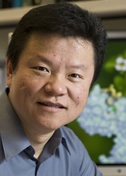Strength in Numbers
Joseph Ho
Academia Sinica, Taiwan
Published March 18, 2013
In graduate school at Boston University, Meng-Chiao (Joseph) Ho nearly quit science. He had chosen to focus on a difficult problem, solving a perfectly twinned protein crystal without a homology model to use for phases. His mentor, Karen Allen, a biochemist and crystallographer, had already spent 12 years trying to solve the structure. After 5 more years and no results worth reporting, Ho had a choice: graduate without a paper to his name or give up.
"I almost became a chef," says Ho, who is now an assistant research fellow at the Institute of Biological Chemistry, Academia Sinica in Taiwan. "What's the difference between a chef and a biochemist? I already knew how to cook by recipe."
After a trip home to Taiwan to renew his visa, Ho gave the project one more shot by working on orthologs to find an untwinned candidate. This time he and Allen succeeded.
Ho published the findings in Nature and landed himself a post-doctoral fellowship in the laboratory of Vern Schramm, chair of the Department of Biochemistry at the Albert Einstein College of Medicine. An expert in drug discovery, Schramm maintained a steady state of over a dozen projects, with ten postdocs, at least one being a protein crystallographer.
When Ho arrived in 2007, he filled this role, even though so far he had only solved three structures. By the time he left, he had worked on at least fifty structures and had published ten papers. "This was a fantastic time for me to learn the ins and outs of solving structures," says Ho, who also worked under structural biologist Steven Almo, a longtime collaborator with Schramm.
The crush of simultaneous projects suited him. "When you have multiple projects, you always feel comfortable," says Ho. There's always enough work to allow for breaks from the tough problems and progress on the straightforward ones.
With the pressure off, says Ho, he "accidentally" solved another difficult problem: a ricin toxin bound to one of Schramm's inhibitors. In one of many attempts to form a crystal with the ligand inside the active site, Ho took too long to fish out his crystals so the crystal dried out. Since he had some beam time available at Brookhaven National Laboratory, he collected the data anyway. "It wasn't a clear picture, but there was something in the pocket and the crystal lattice had shrunk a bit," he says. Using a "poor-man's dehydrator" (cutting the well open to allow crystals dry out and waiting), he eventually hit just the right level of dehydration and solved the structure.
In 2011, when Ho moved back to Taiwan to build his own lab, he took these two experiences as key lessons. "No one should focus on just one crystallography project," he says. "The chance of a blackout is too high." To support his multi-project idea, he built his own medium throughput protein production platform.
Ho also decided to join SBGrid. Having been involved in software upgrades at Albert Einstein, he knew the challenges of keeping the systems up to date and synchronized. "With SBGrid, everything is upgraded at once and our work stays consistent," he says.
In keeping with his interest in drug discovery, Ho chose to zoom in on a pharmaceutically important family of enzymes, protein arginine methyltransferases (PRMTs), which regulate many cellular functions, from gene regulation to cell growth. PRMTs also interact with multiple protein substrates, so there are many projects to work on.
Ho and collaborators recently solved the Xenopus form of a PRMT5-MEP50 complex, important in embryonic development and aberrant in some forms of cancer. Ho reported the findings within months of publication of the human structure by scientists at Eli Lilly and is now investigating the possibility that the complex may be relevant for substrate selectivity.
- Elizabeth Dougherty





































































































































